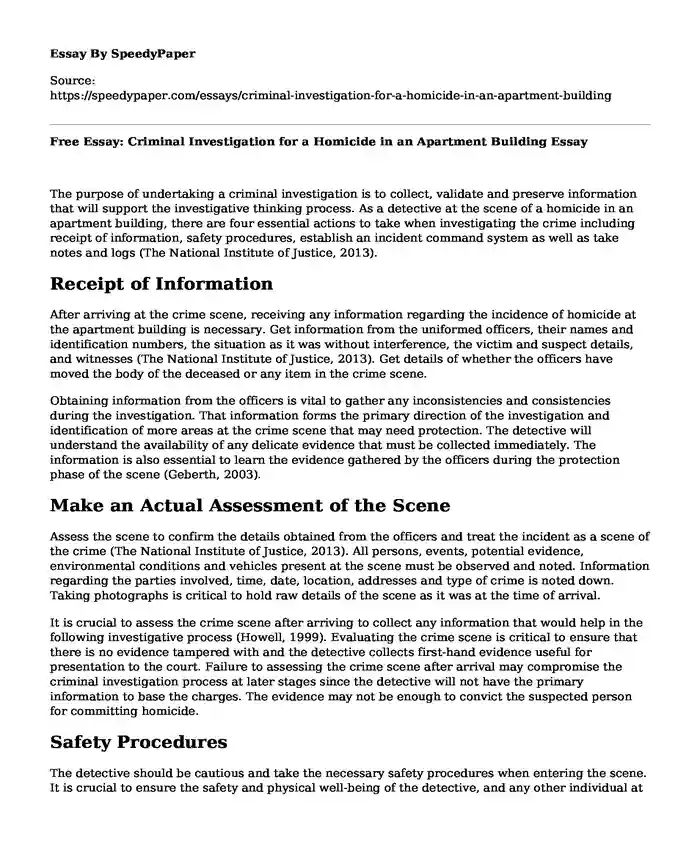
| Type of paper: | Essay |
| Categories: | Criminal law |
| Pages: | 3 |
| Wordcount: | 817 words |
The purpose of undertaking a criminal investigation is to collect, validate and preserve information that will support the investigative thinking process. As a detective at the scene of a homicide in an apartment building, there are four essential actions to take when investigating the crime including receipt of information, safety procedures, establish an incident command system as well as take notes and logs (The National Institute of Justice, 2013).
Receipt of Information
After arriving at the crime scene, receiving any information regarding the incidence of homicide at the apartment building is necessary. Get information from the uniformed officers, their names and identification numbers, the situation as it was without interference, the victim and suspect details, and witnesses (The National Institute of Justice, 2013). Get details of whether the officers have moved the body of the deceased or any item in the crime scene.
Obtaining information from the officers is vital to gather any inconsistencies and consistencies during the investigation. That information forms the primary direction of the investigation and identification of more areas at the crime scene that may need protection. The detective will understand the availability of any delicate evidence that must be collected immediately. The information is also essential to learn the evidence gathered by the officers during the protection phase of the scene (Geberth, 2003).
Make an Actual Assessment of the Scene
Assess the scene to confirm the details obtained from the officers and treat the incident as a scene of the crime (The National Institute of Justice, 2013). All persons, events, potential evidence, environmental conditions and vehicles present at the scene must be observed and noted. Information regarding the parties involved, time, date, location, addresses and type of crime is noted down. Taking photographs is critical to hold raw details of the scene as it was at the time of arrival.
It is crucial to assess the crime scene after arriving to collect any information that would help in the following investigative process (Howell, 1999). Evaluating the crime scene is critical to ensure that there is no evidence tampered with and the detective collects first-hand evidence useful for presentation to the court. Failure to assessing the crime scene after arrival may compromise the criminal investigation process at later stages since the detective will not have the primary information to base the charges. The evidence may not be enough to convict the suspected person for committing homicide.
Safety Procedures
The detective should be cautious and take the necessary safety procedures when entering the scene. It is crucial to ensure the safety and physical well-being of the detective, and any other individual at the crime scene in the apartment building (Howell, 1999). Therefore, with the help of the police officers, it is critical to identify and control any dangerous situation and persons at the scene of the crime. Holding into custody the roommate of the deceased man is vital to avoid any possible physical attack to the detective and the officers at the crime scene. Collect the knife on the floor as it is a dangerous weapon that can be used to harm the people around there. Keep the sharp object as part of the evidence of the tool used to commit homicide.
Approaching the crime scene in a manner that reduces the risk of everyone is critical for safety purposes (The National Institute of Justice, 2013). It reduces the risk of harm to the detective and witnesses by ensuring that there is no immediate threat to those responding to the crime. Failure to taking the action of taking safety procedures compromises the situation, and the suspected criminal may cause harm to others in the crime scene.
Take Notes and Logs
As a detective assigned to the crime scene for investigation, it is necessary to keep notes and logs of the activities undertaken. Taking notes and logs ensures that the detective has a permanent record of the events that took place at the scene of the crime. Ensure to create and detail all entry and exit activities in the apartment. All documents about the crime scene location, the people at the crime scene and why they are there, the name of the victim and suspect and any possible witness should be kept. Failure to take notes may result in not having essential records of information needed during prosecution. When going to a trial at a later date, the detective will not be able to present a full story of what one saw there, and the evidence may be assumed to be mere speculation without a physical backup.
References
Geberth, V. (2003). The homicide crime scene: Practical homicide investigation. CRC Press.Howell, J. (1999). Homicide investigation standard operating procedures. Retrieved from http://www.policeforum.org/assets/docs/Free_Online_Documents/Homicide/homicide%20investigation%20standard%20operating%20procedures%201999.pdf
The National Institute of Justice. (2013). Crime scene investigation: A guide for law enforcement. Retrieved from https://www.nist.gov/sites/default/files/documents/forensics/Crime-Scene-Investigation.pdf
Cite this page
Free Essay: Criminal Investigation for a Homicide in an Apartment Building. (2022, Jul 15). Retrieved from https://speedypaper.net/essays/criminal-investigation-for-a-homicide-in-an-apartment-building
Request Removal
If you are the original author of this essay and no longer wish to have it published on the SpeedyPaper website, please click below to request its removal:
- Free Essay: Being a Member of a Family Presents Numerous Challenges
- Literary Essay Sample: Perseverance in Esperanza Rising
- Analysis of Spring Prospect and South of the Walls We Fought. Free Essay.
- What is the mission of your school?
- Essay Sample on The Gambia
- Essay Sample on Hazard Identification: Risk Assessment and Mitigation Process
- Free Essay. Gender Pay Gap As an Ethical Issue
Popular categories




